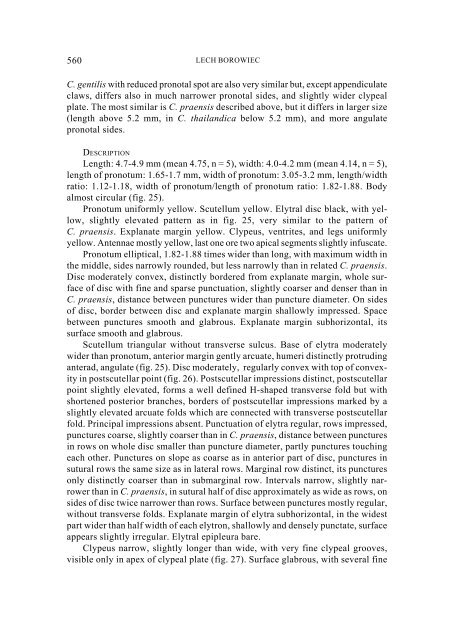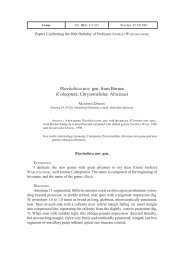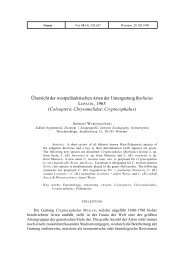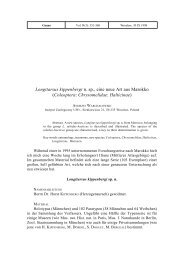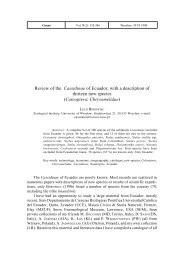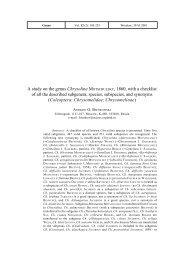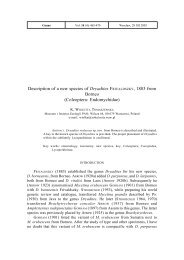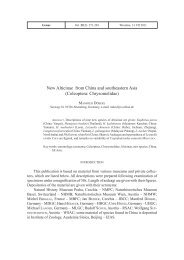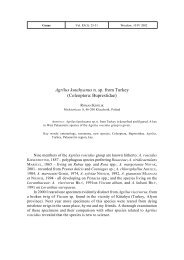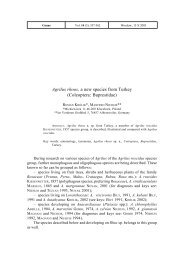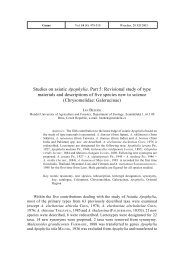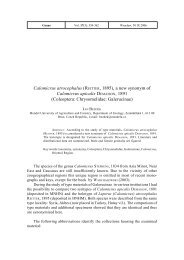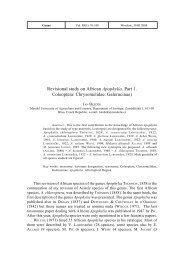New records of Asian and Australopapuan Cassidinae, with a ...
New records of Asian and Australopapuan Cassidinae, with a ...
New records of Asian and Australopapuan Cassidinae, with a ...
You also want an ePaper? Increase the reach of your titles
YUMPU automatically turns print PDFs into web optimized ePapers that Google loves.
560<br />
LECH BOROWIEC<br />
C. gentilis <strong>with</strong> reduced pronotal spot are also very similar but, except appendiculate<br />
claws, differs also in much narrower pronotal sides, <strong>and</strong> slightly wider clypeal<br />
plate. The most similar is C. praensis described above, but it differs in larger size<br />
(length above 5.2 mm, in C. thail<strong>and</strong>ica below 5.2 mm), <strong>and</strong> more angulate<br />
pronotal sides.<br />
DESCRIPTION<br />
Length: 4.7-4.9 mm (mean 4.75, n = 5), width: 4.0-4.2 mm (mean 4.14, n = 5),<br />
length <strong>of</strong> pronotum: 1.65-1.7 mm, width <strong>of</strong> pronotum: 3.05-3.2 mm, length/width<br />
ratio: 1.12-1.18, width <strong>of</strong> pronotum/length <strong>of</strong> pronotum ratio: 1.82-1.88. Body<br />
almost circular (fig. 25).<br />
Pronotum uniformly yellow. Scutellum yellow. Elytral disc black, <strong>with</strong> yellow,<br />
slightly elevated pattern as in fig. 25, very similar to the pattern <strong>of</strong><br />
C. praensis. Explanate margin yellow. Clypeus, ventrites, <strong>and</strong> legs uniformly<br />
yellow. Antennae mostly yellow, last one ore two apical segments slightly infuscate.<br />
Pronotum elliptical, 1.82-1.88 times wider than long, <strong>with</strong> maximum width in<br />
the middle, sides narrowly rounded, but less narrowly than in related C. praensis.<br />
Disc moderately convex, distinctly bordered from explanate margin, whole surface<br />
<strong>of</strong> disc <strong>with</strong> fine <strong>and</strong> sparse punctuation, slightly coarser <strong>and</strong> denser than in<br />
C. praensis, distance between punctures wider than puncture diameter. On sides<br />
<strong>of</strong> disc, border between disc <strong>and</strong> explanate margin shallowly impressed. Space<br />
between punctures smooth <strong>and</strong> glabrous. Explanate margin subhorizontal, its<br />
surface smooth <strong>and</strong> glabrous.<br />
Scutellum triangular <strong>with</strong>out transverse sulcus. Base <strong>of</strong> elytra moderately<br />
wider than pronotum, anterior margin gently arcuate, humeri distinctly protruding<br />
anterad, angulate (fig. 25). Disc moderately, regularly convex <strong>with</strong> top <strong>of</strong> convexity<br />
in postscutellar point (fig. 26). Postscutellar impressions distinct, postscutellar<br />
point slightly elevated, forms a well defined H-shaped transverse fold but <strong>with</strong><br />
shortened posterior branches, borders <strong>of</strong> postscutellar impressions marked by a<br />
slightly elevated arcuate folds which are connected <strong>with</strong> transverse postscutellar<br />
fold. Principal impressions absent. Punctuation <strong>of</strong> elytra regular, rows impressed,<br />
punctures coarse, slightly coarser than in C. praensis, distance between punctures<br />
in rows on whole disc smaller than puncture diameter, partly punctures touching<br />
each other. Punctures on slope as coarse as in anterior part <strong>of</strong> disc, punctures in<br />
sutural rows the same size as in lateral rows. Marginal row distinct, its punctures<br />
only distinctly coarser than in submarginal row. Intervals narrow, slightly narrower<br />
than in C. praensis, in sutural half <strong>of</strong> disc approximately as wide as rows, on<br />
sides <strong>of</strong> disc twice narrower than rows. Surface between punctures mostly regular,<br />
<strong>with</strong>out transverse folds. Explanate margin <strong>of</strong> elytra subhorizontal, in the widest<br />
part wider than half width <strong>of</strong> each elytron, shallowly <strong>and</strong> densely punctate, surface<br />
appears slightly irregular. Elytral epipleura bare.<br />
Clypeus narrow, slightly longer than wide, <strong>with</strong> very fine clypeal grooves,<br />
visible only in apex <strong>of</strong> clypeal plate (fig. 27). Surface glabrous, <strong>with</strong> several fine


